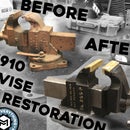Introduction: How To: Log Slice Side Table
In this project I take a slice off a log (also known as a "cookie") and turn it in to a side table! The base is welded up out of 1" x 1" square steel tubing, with 1" x 1/4" flat stock attached to the wooden top.
See the video below to watch me build this, or continue into this instructable to read a detailed description of all the steps!
Leave any questions in the comments!
Step 1: Cutting the Slice.
To start this project your gonna need a slice off a log. In my case I had a red oak log about 28" in diameter that we cut up. I sliced the log into approximately 5" thick pieces.
I just got myself a Husqvarna 3120xp chainsaw, and I wanted to test it out with the 42" bar. THIS THING RIPS.
Disclaimer:
CHAINSAWS ARE DANGEROUS AND THEY WILL HURT YOU, BE CAREFUL.
Step 2: Sketch Out Your Table, Select Your Material.
If your cutting up your own logs, you'll want to give them time to dry out before making anything out of them. If your getting a slice off a log from someone else, you'll want to design your table around the shape of the wood.
I chose to make my table 24" high, with a 18" wide base.
The log round is 28" in diameter.
Step 3: Removing Rotten Bark.
This red oak log sat outside for a number of years before this project took place, so there was a good amount of soft rotten wood around the outside of the piece.
Using a hatchet I chopped the soft material away, leaving good strong wood as the edge of the table top.
Step 4: Raising the Edge Grain
Since the wood was very soft around the perimeter, I decided I wanted to remove the remaining loose grain with a wire wheel.
This is a quick way to get a great result with this type of rotten wood. I run the wire wheel WITH the grain on the edge so that it pulls out the loose fibers and leaves the sturdy fibers. The effect makes it look like the side of a volcano or mountain.
Step 5: Sanding the Top.
This top was pretty rough from the chainsaw cut, so I had to take a good amount of material away to make it useable.
I used this Porter Cable "Restorer" tool to take the saw marks out. This thing works GREAT. I had an 80 grit drum on it and it shredded through the wood very quickly, and get the top nice and flat.
After that was done I took a 150 pad on my orbital sander and made the whole top nice and smooth.
Step 6: Starting the Base.
Now that the top is nearly done, time to start on the base.
For the base I used 1"x1" square steel tubing as the legs, 1/4" x 1" flat stock as the top of the base, and 1/2" x 1/2" material to connect the legs in a "X" pattern.
The first piece I will weld up is the top of the base. It wound up being a 16" x 16" square.
Step 7: Bonus Step: a Trick to Square Up Stock on the Grinder.
Heres a little tip for squaring up stock on a belt grinder.
If you square a piece of scrap material (aluminum steel, even wood works) on both the X and Y Axis you can make a fence that will allow you to make your material perfectly square.
I use an aluminum block, first squaring it to the flat platten, then squaring the platten to the work rest. Now I can run my material against that into the grinding belt and it will make it perfectly square.
Step 8: Cutting the Legs
I measure the thickness of the log again and then cut the legs to get me the 24" total height I wanted from my original sketch.
I use the squaring trick on the belt grinder to make sure all the legs are exactly the same length.
Step 9: Welding on the Legs
Once the legs are all the same length I start to assemble the base.
I tack the legs on, make sure they are square and add a little more to the weld to keep them sturdy. I will go back and finish weld every seam once I know the base will function as I want it to.
Step 10: Adding Cross Braces
Once the legs are attached I use some 1/2" x 1/2" square stock to make some cross braces for the base.
These cross bases are both for structure and design. When adding cross braces like this it makes it much waster to use clamps or scrap material to prop up the braces while welding. I intentionally left a little gap in-between them where they intersect, I like the shadow it creates.
Step 11: Checking the Base.
I do a test fit of the base underneath the top to make sure it all looks good before I complete the welding/grinding.
Step 12: Finish Welding the Base.
Once I know the base is how I want it to be I complete all the welding and grinding. I give full seamed welds on every section, and grind them back to look smooth and clean.
WEAR RESPIRATORY PROTECTION WHEN GRINDING METAL
ALWAYS PROTECT YOUR EYES.
Step 13: Attaching the Base.
Once the base it all welded and grinded its time to screw it to the top. I drilled slightly oversized holes and used 1 1/2" galvanized screws to attach the base. The holes are a little oversized so that if the top starts to move around the screws have somewhere to go. They are tight, but not too tight.
Step 14: Finishing the Top.
To finish off the top I used some clear mineral oil. I like the way it looks, it protects the wood and has no odor. I also took the time to brush it into the edge of the top where the bark was. This was time consuming but it left it looking very nice and finished.
Step 15: Enjoy the Table!
You did it!
I built this table to live outside in my yard. You will notice that I didn't finish the base, or go too crazy with grinding my welds. Sometimes, thats okay. I want the base to weather, like the top will, and it it gets really rusty, that might look great! I hope you enjoyed this project! if you have any questions, leave them int he comments and Ill be happy to answer them.
Be careful when working with tools!!!!
Follow my shop on Instagram www.instagram.com/makeeverythingshop
And subscribe to my youtube! www.youtube.com/makeeverything

Participated in the
Makerspace Contest 2017













